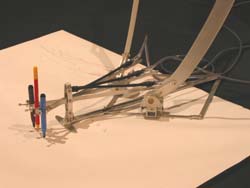Researchers use lab cultures to create robotic ’semi-living artist’

The robotic drawing arm operates based on the neural activity of a few thousand rat neurons placed in a special petri dish that keeps the cells alive. <br>
Working from their university labs in two different corners of the world, U.S. and Australian researchers have created what they call a new class of creative beings, “the semi-living artist” – a picture-drawing robot in Perth, Australia whose movements are controlled by the brain signals of cultured rat cells in Atlanta.
Gripping three colored markers positioned above a white canvas, the robotic drawing arm operates based on the neural activity of a few thousand rat neurons placed in a special petri dish that keeps the cells alive. The dish, a Multi-Electrode Array (MEA), is instrumented with 60 two-way electrodes for communication between the neurons and external electronics. The neural signals are recorded and sent to a computer that translates neural activity into robotic movement.
The network of brain cells, located in Professor Steve Potter’s lab at the Georgia Institute of Technology in Atlanta, and the mechanical arm, located in the lab of Guy Ben-Ary at the University of Western Australia in Perth, interact in real-time through a data exchange system via an Internet connection between the robot and the brain cells.
And while the robot’s drawings won’t put any artists out of business (picture the imaginative scribbling of a three-year-old), the semi-living artist’s work has a deeper significance. The team hopes to bridge the gap between biological and artificial systems to produce a machine capable of matching the intelligence of even the simplest organism.
“We’re attempting to create an entity that over time will evolve, learn, and express itself through art,” said Potter, a professor in the Wallace H. Coulter Department of Biomedical Engineering at Georgia Tech and Emory University.
Potter and his team in the Laboratory for Neuroengineering at Georgia Tech began collaborating with Ben-Ary’s team at Western Australia in 2002. They call the robot “MEART,” which stands for multi-electrode array art. The project combines the technology of multi-electrode arrays at Potter’s lab with the robotic and artistic ingenuity of the team at Western Australia, called the “SymbioticA Research Group.”
At the time, Ben-Ary and his group were conducting research into meshing biological technology and artistry in a project called “Fish & Chips.” In that project, the team used music to stimulate electrical activity from a few fish neurons cultured on silicon chips, which in turn controlled a robotic arm.
“The goals are both to learn more about how brains work and to apply what is learned to designing fundamentally different types of artificial computing systems,” said Ben-Ary, who directs the Image Acquisition and Analysis Facility in the School of Anatomy and Human Biology at Western Australia.
Meanwhile, Potter’s group was already connecting cultures containing living neurons to computers using multi-electrode arrays that stimulate and record mammalian neurons. Most notably, the group developed the first robotic device whose movements are controlled by a cultured neural network capable of adaptive behavior and learning. They call the hybrid robot a “Hybrot.”
The neural activity recorded by the electrodes is transmitted over a two-way communication system and processed both in Atlanta and Perth to control the robotic drawing arm. Depending on how the neuro-electrical activity fires, the robotic arm will draw on a portion of the canvas or choose how many colored markers to use at one time and which colors it will use.
Central to the experiments is Potter’s belief that over time the teams will be able to establish a cultured in vitro network system that learns like the living brains in people and animals do. To achieve that, the information from the robot’s sensors is sent back through the system to the cultured network of cells in the form of electrical stimuli. By closing the loop, the group hopes the robot will learn something about itself and its environment.
“I hope that this merging of art and science will get the artists thinking about our science, and the scientists thinking about what is art and what is the minimum needed to make a creative entity,” Potter said. “On the science side, I hope that we can look at the drawings it makes and see some evidence of learning. Then we can scrutinize the cultured network under the microscope to help understand the learning process at the cellular level.”
At the University of Western Australia, the SymbioticA Research Group is managed by Oron Catts and directed by Professors Miranda Grounds and Stuart Bunt in the School of Anatomy and Human Biology. Phil Gamblen developed the robotic arm.
Note: The semi-living artist will be on display at “ArtBots: The Robot Talent Show” (http://artbots.org) in New York City July 12 and 13 at the Eyebeam Gallery.
Media Contact
More Information:
http://www.gatech.edu/news-room/release.php?id=160All latest news from the category: Interdisciplinary Research
News and developments from the field of interdisciplinary research.
Among other topics, you can find stimulating reports and articles related to microsystems, emotions research, futures research and stratospheric research.
Newest articles

Witness Groundbreaking Research on Achilles Tendon Recovery
Achilles tendon injuries are common but challenging to monitor during recovery due to the limitations of current imaging techniques. Researchers, led by Associate Professor Zeng Nan from the International Graduate…

Why Prevention Is Better Than Cure—A Novel Approach to Infectious Disease Outbreaks
Researchers have come up with a new way to identify more infectious variants of viruses or bacteria that start spreading in humans – including those causing flu, COVID, whooping cough…

Durable, Efficient, Sustainable: The Rise of Cerium Oxide Thermal Switches
Groundbreaking cerium oxide-based thermal switches achieve remarkable performance, transforming heat flow control with sustainable and efficient technology. Cerium Oxide-Based Thermal Switches Revolutionize Heat Flow Control Thermal switches, which electrically control…



